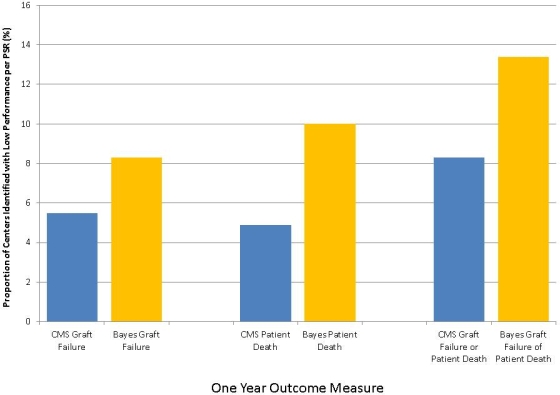Simulating Alternative Bayesian Criteria to Identify Transplant Center Performance Outliers.
1Cleveland Clinic, Cleveland, OH
2Ohio State University, Columbus, OH
3University of Florida, Gainesville, FL.
Meeting: 2016 American Transplant Congress
Abstract number: C64
Keywords: Adverse effects, Multivariate analysis, Public policy, Survival
Session Information
Session Name: Poster Session C: Economics, Public Policy, Allocation, Ethics
Session Type: Poster Session
Date: Monday, June 13, 2016
Session Time: 6:00pm-7:00pm
 Presentation Time: 6:00pm-7:00pm
Presentation Time: 6:00pm-7:00pm
Location: Halls C&D
The newly constructed Bayesian models to evaluate transplant center performance were implemented in 2014. The rates and impact of the assumptions used for flagging centers have not been critically examined.
We used data from six consecutive biannual SRTR Program-Specific Reports([PSR],January,2013-July,2015) to evaluate incidence of low performance ratings for 1-year graft or patient survival among US adult kidney transplant centers. We simulated modifying criteria for flagging and compared centers identified for low performance to current MPSC and CMS standards. Current Bayesian criteria generate a performance “flag” based on 75% probability of Mean Hazard Ratio[MHR]>1.2 OR 10% probability of MHR>2.5.
Among programs performing ≥10 transplants, there were 1230 graft and 1222 patient survival PSRs during the period. Based on CMS criteria 68(5.5%) and 60(4.9%) PSRs were flagged for one-year graft and patient survival respectively and 101(8.3%) PSRs for either outcome. Based on Bayesian criteria 102(8.3%) and 122(10.0%) PSRs were flagged for one-year graft and patient survival respectively and 164(13.4%) PSRs for either outcome. Altering Bayesian criteria from 75% probability of MHR>1.2 to 80%,85%,90% resulted in 11.0%, 9.3%,8.0% PSRs flagged. Altering criteria from 75% probability of MHR≥1.2 to 75% probability of MHRs>1.3,1.4,1.5 resulted in 9.6%, 8.0%,7.2% PSRs flagged. Using 90% probability of MHR>1.1 or 15% probability of MHR>2.5 resulted in 7.8% of PSRs flagged. Altering the “OR” condition to an “AND” condition using current Bayesian criteria resulted in 4.9% of PSRs flagged.
Altering Bayesian criteria from 75% probability of MHR>1.2 to 80%,85%,90% resulted in 11.0%, 9.3%,8.0% PSRs flagged. Altering criteria from 75% probability of MHR≥1.2 to 75% probability of MHRs>1.3,1.4,1.5 resulted in 9.6%, 8.0%,7.2% PSRs flagged. Using 90% probability of MHR>1.1 or 15% probability of MHR>2.5 resulted in 7.8% of PSRs flagged. Altering the “OR” condition to an “AND” condition using current Bayesian criteria resulted in 4.9% of PSRs flagged.
Based on current Bayesian criteria, 13% of PSRs with at least 10 transplants are identified for low performance every six months with increased rates relative to CMS criteria. Modification of performance criteria to more reasonable definitions of outliers may minimize the breadth of flagging, reduce risk adverse behavior and potentially more efficiently allocate resources on centers with more dramatic outcome differences.
CITATION INFORMATION: Schold J, Miller C, Henry M, Buccini L, Flechner S, Goldfarb D, Poggio E, Andreoni K. Simulating Alternative Bayesian Criteria to Identify Transplant Center Performance Outliers. Am J Transplant. 2016;16 (suppl 3).
To cite this abstract in AMA style:
Schold J, Miller C, Henry M, Buccini L, Flechner S, Goldfarb D, Poggio E, Andreoni K. Simulating Alternative Bayesian Criteria to Identify Transplant Center Performance Outliers. [abstract]. Am J Transplant. 2016; 16 (suppl 3). https://atcmeetingabstracts.com/abstract/simulating-alternative-bayesian-criteria-to-identify-transplant-center-performance-outliers/. Accessed December 18, 2025.« Back to 2016 American Transplant Congress
